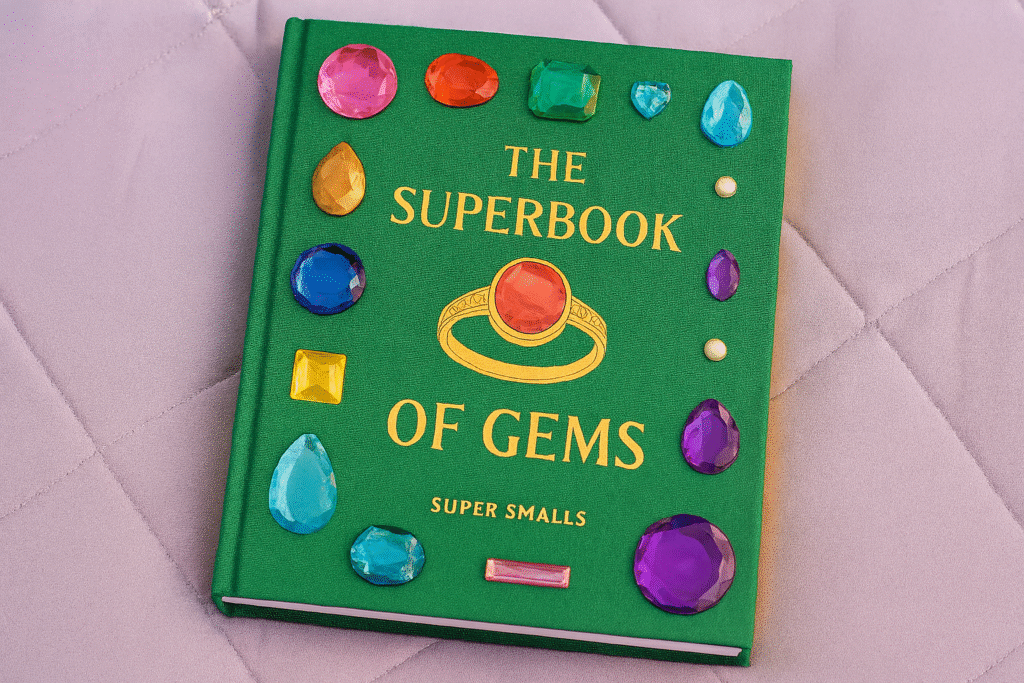Introduction
The Superbook of Gems by Super Smalls is more than just a children’s book. It is a deluxe kids’ coffee table guide that explores the fascinating world of gems and birthstones. Month by month, this book introduces young readers to twelve birthstones through stories, scientific facts, and colorful photography. Parents looking for an engaging gem book for kids will find that The Superbook of Gems by Super Smalls sparks curiosity and builds lasting knowledge about gemstones.
What Makes The Superbook of Gems by Super Smalls Special?
This gem book for kids combines history, culture, and science in a way that is easy to understand. Each chapter highlights:
- Birthstone origins and traditions
- Scientific details like hardness on the Mohs scale
- Stunning photographs of jewelry and giant gems
- Stories from history and mythology
If your child wants to explore more about how gems are studied, see the Beginner’s Guide to Gemology and Understanding BIS Hallmark.
Learn Birthstones Month by Month
From January’s garnet to December’s turquoise, The Superbook of Gems by Super Smalls takes children through a year of gems. Examples include:
- January – Garnet: A gem known for strength and protection
- April – Diamond: The most popular gemstone, making up about 78% of global gem sales
- September – Sapphire: A royal gem admired for centuries
For further reading: Visit the Gemological Institute of America (GIA) to see more gemstone research.
Why Kids Love The Superbook of Gems by Super Smalls
Research shows that visual learning improves memory retention by 65%. With full-page photos and easy-to-read facts, children stay engaged while learning about gems. Many parents note that kids look for their own birthstone after reading this book.
Expert View on Gemstone Education
With 40+ years in gemology, we know that gemstone education builds lasting interest. Books like The Superbook of Gems by Super Smalls make gems relatable to children and encourage appreciation for nature’s treasures.
For more guides, explore the articles on 24K, 22K, and 18K Gold and Engagement Ring Buying Tips.
FAQ – The Superbook of Gems by Super Smalls
Q: Who is The Superbook of Gems by Super Smalls for?
A: It is designed for children ages 6–12 but also appeals to adults who enjoy gemstones.
Q: How many gems are included?
A: The book covers 12 main birthstones, plus highlights of other rare gems.
Q: Can this book be used for school projects?
A: Yes, the mix of history, science, and culture makes it an excellent reference.
Q: Does it include real gemstone photos?
A: Yes, it contains both illustrations and high-quality photographs.
India Regional Cultures: A Complete Diversity Guide
India regional cultures are as diverse as its landscapes. This guide explores traditions, languages, and unique identities across the country. India Speaks FAQ on regional cultures reveals remarkable diversity across the subcontinent. Each state tells a unique story of tradition, heritage, and identity.
This India Speaks FAQ on regional cultures explores how geography, history, and local customs shape the cultural differences across India’s states and territories.
Understanding these regional differences helps you appreciate India’s true cultural richness.
What Makes India’s Regional Cultures Unique?
Each state develops its own distinct language, cuisine, and customs over centuries. Local history shapes traditions and daily life. Geography influences everything from clothing styles to building designs and lifestyle choices.
Examples of regional adaptation:
- Kashmir’s wooden homes with sloped roofs handle heavy snowfall
- Kerala’s houseboats work perfectly with extensive waterways and monsoon climate
- Rajasthan’s thick-walled buildings stay cool in desert heat
These regional adaptations show how different communities respond to their environment while keeping cultural identity.
How Do Regional Foods Reflect India’s Cultural Diversity?
Regional cuisine connects directly to local climate and crops. Coastal regions favor rice cultivation and seafood preparation. Northern states rely on wheat-based breads like roti, naan, and paratha.
Cooking methods vary significantly across regions:
- Mustard oil dominates Bengali cuisine
- Coconut oil is essential in Kerala cooking
- Ghee remains the preferred fat in Rajasthani dishes
When you travel across India, pay attention to these culinary differences. They reveal stories about the land, climate, and cultural preferences. India Speaks FAQ on regional cultures shows these food traditions matter.
Why Are Languages Central to Regional Identity in India?
India speaks through 22 official languages and hundreds of regional dialects. Each language carries unique cultural meaning. Language shapes traditional songs, folk tales, religious festivals, and social customs.
Language examples and their cultural significance:
- Tamil expresses the rich Dravidian heritage of South India
- Punjabi reflects Sikh traditions and agricultural lifestyle
- Bengali carries the literary legacy of Nobel laureate Rabindranath Tagore
- Hindi serves as a connecting language across northern states
Learning even a few local words helps you connect with regional communities. It shows respect for local culture.
What Role Do Festivals Play in India’s Regional Cultures?
Festivals serve as powerful expressions of regional identity. They bring communities together through shared traditions and celebrations. Each region celebrates differently based on local customs, crop cycles, and religious practices.
Regional festival examples:
- North India illuminates Diwali with millions of oil lamps and fireworks
- South India honors Pongal with harvest rituals celebrating farmers and nature
- West Bengal transforms during Durga Puja with art installations, classical music, and community feasting
Each festival reflects the unique cultural values and historical experiences of its region.
Which festival would you want to experience firsthand?
How Does Traditional Clothing Vary Across Indian Regions?
Climate conditions and available resources influence regional clothing styles across India. These variations demonstrate practical adaptation to different environments while maintaining aesthetic preferences.
Regional clothing examples:
- Rajasthan’s desert climate inspires bright turbans, flowing skirts, and mirror-work textiles that reflect heat
- Kerala’s humid tropical climate favors white cotton sarees with golden borders worn during festivals
- Nagaland’s mountainous terrain produces distinctive shawls featuring tribal symbols and geometric patterns
Each style represents clan identity and cultural heritage specific to its region.
How Do Regional Crafts and Arts Represent Cultural Identity?
Traditional crafts carry centuries of accumulated skill and cultural meaning. They serve as living expressions of regional identity. These art forms express creativity through traditions passed down through generations.
Regional craft examples:
- Bihar’s Madhubani paintings feature mythological themes and geometric patterns created by women during festivals
- Kerala’s Kathakali dance combines dramatic storytelling, classical music, and elaborate costumes
- Odisha’s traditional metalwork, particularly brass and bronze artifacts, carries deep ritual meaning in temple worship
Supporting these regional crafts helps preserve cultural heritage. It provides sustainable livelihoods for traditional artisans.
Why Should You Explore India’s Regional Cultures?
Exploring regional cultures offers experiences beyond visiting monuments and tourist attractions. You engage directly with daily life, authentic cuisine, and living languages.
Regional travel provides meaningful context rather than surface-level tourist highlights.
Benefits of regional cultural exploration:
- You connect with local communities on a personal level
- You taste authentic dishes prepared with traditional methods
- You hear regional languages and dialects in natural settings
- You witness festivals and ceremonies as they happen in daily life
Each regional visit deepens understanding of India’s diversity. It helps you appreciate how different communities adapt to their environments while keeping distinct cultural identities.
India Speaks FAQ on regional cultures demonstrates what makes the country culturally rich and endlessly fascinating for travelers and cultural enthusiasts.
Which region would you choose to explore first?




